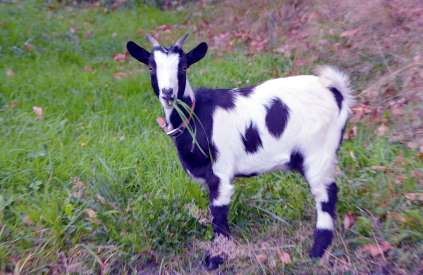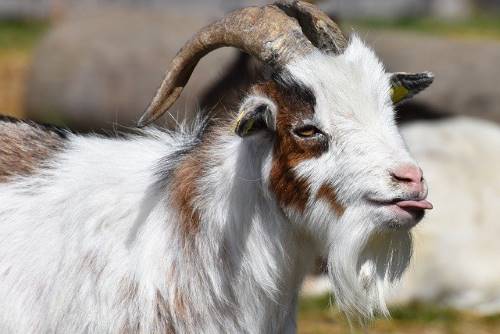Can goats eat magnolia leaves? Yes, goats can eat magnolia leaves and most goats will love them. The leaves from magnolia trees are not considered to be toxic to any animal, so they are safe for your goats. Eating large quantities of any plant might be bad for your goats’ health, so always give them in moderation.
There are a couple of things to remember when it comes to magnolia leaves and goats. In this article, you’ll learn everything there is to know about feeding magnolia leaves to your goats.

What are Magnolia Leaves?
Magnolia leaves are the leaves from a magnolia tree. These trees are typically found in the southeastern United States. The leaves of a magnolia tree have a sweet taste and a mild smell. They are often eaten by deer, rabbits, and other wildlife.
There are over 100 different species of magnolia trees. The leaves from these trees can vary in size, shape, and color. Some magnolia leaves are green, while others are a reddish-brown color.
Magnolias are considered to be one of the planet’s first blooming plants. They typically bloom in the early spring.
[GoatAffiliate]
Can Goats Eat Magnolia Leaves?
Yes, goats can eat magnolia leaves and they will love them. The leaves from a magnolia tree are not toxic to any animal, so they are safe for your goats to eat. However, you should always give them in moderation. Too many magnolia leaves could be bad for your goats’ health.
Are Magnolia Leaves Safe for Goats?

Yes, the leaves from a magnolia tree are safe for goats to eat. They are non-toxic to any animal and have a pleasant flavor, as well as a light smell. Goats will enjoy eating them and they will help to keep your goats healthy.
The leaves are a good source of Vitamin C and can help to improve your goats’ digestion. They also help to keep your goats’ coats clean and healthy.
Be sure to provide a variety of different types of leaves and branches for your goats to eat, as they will enjoy eating a wide variety of plants.
Benefits of Magnolia Leaves for Goats
There are several benefits of feeding magnolia leaves to your goats. Magnolia leaves are a good source of Vitamin C, which is important for goats’ health. The leaves also contain other nutrients that help keep goats healthy, including calcium, magnesium, and potassium.
Additionally, magnolia leaves can help goats digest their food better. This is because the leaves contain tannins, which are natural compounds that help to break down food.
Feeding magnolia leaves to goats can also help to control parasites. The leaves contain compounds that kill parasites, which can help to reduce the number of parasites in the goats’ environment.
Overall, feeding magnolia leaves to goats is a great way to improve their health and wellbeing. The leaves are affordable, easy to find, and provide a variety of important nutrients that goats need. So if you have a garden full of magnolias, consider giving some leaves to your goats!
Are there any Risks in Feeding Magnolia Leaves to Goats?

Feeding magnolia leaves to goats is generally safe, but there are a few things to keep in mind. First, feeding too many leaves can be bad for your goats’ health. Always provide them with a limited amount of leaves to eat.
Additionally, some types of tree leaves contain compounds that can be harmful to goats. Be sure to only give your goats leaves from trees that are not poisonous. Some leaves contain toxins that can be dangerous to goats.
So, while feeding magnolia leaves to goats is generally safe, it’s important to be careful and to only give them leaves from safe trees.
How Often Should I Feed my Goats Magnolia Leaves?
You can feed your goats magnolia leaves on a regular basis. However, you don’t need to give them a lot of leaves at once. Just a few leaves per day will be plenty.
Additionally, you should mix magnolia leaves with other types of leaves and branches that your goats can eat. This will give them a variety of different nutrients and flavors, which they will enjoy.
So, feel free to feed your goats magnolia leaves on a regular basis. Just be sure to mix them in with other leaves, and don’t give them too many at once. Your goats will love them and they will benefit from eating them!
Can Goats Eat Magnolia Tree Berries?

Yes, goats can eat magnolia tree berries. The berries are not toxic to any animal and have a pleasant flavor. Goats will enjoy eating them and they will help to keep your goats healthy.
The berries are a good source of Vitamin C, and they also contain high levels of antioxidants. These antioxidants can help to protect your goats from disease. The berries are also a good source of fiber, which is important for the health of your goats.
If you have a magnolia tree on your property, be sure to let your goats eat the berries. They will love them!
Can Goats Eat Magnolia Flowers?
Yes, goats can eat magnolia flowers. Magnolia flowers are a good source of nutrients for goats, including protein, calcium, and phosphorus. Magnolia flowers also contain antioxidants that can help protect the goats from disease. Goats that eat magnolia flowers are likely to be healthier and have stronger immune systems.
What other trees and leaves can goats eat apart from magnolia leaves?
Apart from magnolia leaves, there’s a plethora of trees and foliage that can cater to a goat’s dietary needs. While goats are known for their voracious and often indiscriminate eating habits, it’s essential to ensure they’re consuming safe and beneficial vegetation. Let’s explore some common trees and their leaves that goats might encounter, and whether or not they should be part of a goat’s diet.
Pine Needles
Pine needles are often consumed by goats and can be a beneficial addition to their diet. They contain certain essential oils and nutrients. However, caution is required, especially with pregnant goats. Consuming large amounts of pine needles has been linked to causing miscarriages in them. Thus, while it’s generally safe in small quantities, it’s essential to monitor their consumption, especially if your goat is expecting.
Read More: Can Goats Eat Pine Needles? 5 Important Benefits
Oak Leaves
Oak leaves, particularly from the red oak family, contain tannins which can be harmful to goats if consumed in large quantities. These tannins can cause gastrointestinal issues and affect the kidneys. While goats might nibble on them occasionally, it’s advisable to ensure they don’t consume a significant amount. Offering a diverse diet can help deter them from overindulging in oak leaves.
Read More: Can Goats Eat Oak Leaves? 6 Great Benefits
Christmas Trees
After the holiday season, it might be tempting to offer goats old Christmas trees. While they will gladly munch on them, it’s crucial to ensure the tree hasn’t been treated with any harmful chemicals or fire retardants. Additionally, ensure there are no leftover ornaments or tinsel, as these can be hazardous. Pesticides or other chemicals from commercially grown trees can also pose risks. If you’re sure of the tree’s safety, it can be a delightful post-holiday treat.
Read More: Can Goats Eat Christmas Trees? Myths & Facts Unveiled
Maple Leaves
Certain types of maple leaves, especially wilted ones from the red maple tree, can be toxic to goats. Consumption of these wilted leaves can cause hemolytic anemia, which is a severe condition where the body destroys its own red blood cells. While not all maple varieties pose this risk, it’s advisable to be cautious and prevent goats from consuming large amounts of maple leaves unless you’re certain of the tree’s safety.
Read More: Can Goats Eat Maple Leaves? Simple Answer & Feeding Tips
Cedar Trees
Goats can eat cedar tree foliage, but it’s not their first choice and usually, they’ll only consume it when other food sources are scarce. Some studies suggest that cedar’s natural oils might act as a natural dewormer. However, like all things, moderation is key. Excessive consumption can lead to digestion issues.
Read More: Can Goats Eat Cedar Trees? 6 Excellent Benefits
Can Goats Eat Magnolia Leaves – Final Thoughts
Can goats eat magnolia leaves? Yes, they can! The leaves from a magnolia tree are not considered to be toxic to any animal, so there is no reason why your goat shouldn’t enjoy them.
When feeding your goats these plants in moderation, you must remember that eating large quantities of any plant might have negative effects on the health of your animals.
In this article, I’ve provided information about how best to feed magnolia leaves to your goats and make sure their diet remains balanced and healthy. If you want more tips for caring for your pet or livestock farm animals, let me know by contacting me.
Related Articles:
